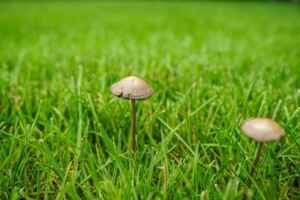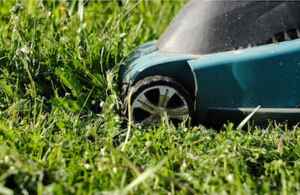How to Spot Lawn Diseases
Being able to spot and identify different lawn diseases is an important part of lawn care. However, lawn diseases come in different forms. So, how do I spot lawn diseases?
Some ways how to spot lawn diseases include discoloration of the grass, thinning grass which can cause patchy grass spots, and fungal growths or mushrooms appearing in your yard.
By identifying and treating any issues as soon as they appear, you can prevent the disease from spreading all over and taking over your lawn. Here are a few things to look out for to help spot lawn disease as soon as it appears.

The Signs of Lawn Disease
One of the major signs of lawn disease is discoloration of the grass blades. If patches of your grass look gray or yellow, it could be a sign of a problem. Inspect the area closely for other signs such as distorted leaves or brown spots on the tips of blades.
You may also notice that affected areas are becoming thin and seeing less regrowth than unaffected areas.
Another sign of lawn disease is fungal growths or mushrooms appearing in the diseased patch. Fungal growths will often be visible and can appear as white or brown spotty growths on the grass blades.
Nobody knows your yard better than you do. You see the grass every day under every condition possible. That is why you are the first line of defense for your grass. Even if your lawn doesn’t have one of these signs above but it looks strange or more dead than usual, it’s probably a good idea to give it a closer look.
If you spot any of these signs, it is important to treat the lawn diseases quickly in order to prevent further spread. The best way to do this is through chemical treatments, however, it is also important to follow any instructions that come with the products carefully in order to minimize damage from overuse. If you are unsure what type of chemical treatment is needed for your lawn condition, contact a professional who can advise you on the best course of action for treating lawn diseases and can help keep your lawn well taken care of. With proper spot treatment and regular care and maintenance, you will be able to keep your lawn healthy and free from disease all year round.
Types of Lawn Diseases
Lawn diseases can be a major annoyance and cause significant damage if not addressed properly or quickly. There are many different types of lawn diseases that can affect lawns, ranging from fungal problems to more exotic lawn diseases like brown patches. Common lawn diseases include Red Thread, Dollar Spot, Brown Patch, Leaf Spot, and Fusarium Blight.
1. Red Thread
Red Thread is a lawn disease caused by a common fungus known as Laetisaria fuciformis. It generally appears in the form of small reddish-pink patches on the lawn and is most common during humid conditions or when nitrogen levels are low on the lawn.
2. Dollar Spot
Dollar spot is another type of lawn disease caused by Sclerotinia homoeocarpa, a fungus that thrives in humid and wet lawns. It appears as circular patches of straw-colored grass with silver dollar-sized spots on the lawn.
3. Brown Patch
Brown patch is a lawn disease caused by Rhizoctonia solani, another common lawn fungus that prefers warm and moist lawns. This lawn disease can cause large brown or tan patches on the lawn, sometimes with darker borders around them.
4. Leaf Spot
Several different fungi including Anthracnose, Phyllosticta, and Drechslera cause Leaf spots. Leaf Spot appears as small spots on the lawn’s blades which may have yellow halos around them.
5. Fusarium Blight
Fusarium blight is an uncommon type of lawn disease caused by Fusarium species. This lawn disease usually appears in the form of small patches of off-color, wilting grass blades.

No matter what lawn diseases you encounter, it’s always important to address them quickly and properly to prevent further damage to your lawn. If you have any questions about lawn diseases or need help addressing a lawn problem, contact a lawn care professional for assistance. They can diagnose the issue correctly and provide treatment recommendations so your lawn can be healthy again and keep your lawn taken care of.
How to Treat Lawn Diseases
When it comes to lawn diseases, there are three main treatment options: prevention, early detection, and chemical control. Prevention measures can include avoiding over-watering or mowing the lawn too short. Early detection is key in order to stop a lawn disease from becoming too severe and spreading. Signs of lawn diseases include discoloration, lesions, or dead patches in the lawn. Chemical control is typically used when other treatments aren’t able to keep the lawn disease under control. This involves using fungicides that target specific types of lawn diseases and can be sprayed onto infected areas of the lawn. It’s important to follow all instructions on the label when applying any type of pesticide in order to prevent unnecessary harm to humans, pets, and the environment. By treating lawn diseases early and using proper prevention measures, lawn owners can keep their lawns looking healthy and green.
Overall, lawn diseases can be a nuisance quickly spiraling out of control if not managed properly. Unfortunately, lawn disease can also have a significant impact on your garden. They can weaken the root system and kill off your plants. However, with a bit of knowledge and effort, they can be easily prevented or treated with targeted chemical controls when necessary. With the right care, lawn owners will have a beautiful lawn to enjoy for many years.

How to Prevent Lawn Diseases
Taking preventative measures is the best way to keep lawn diseases at bay. Proper lawn maintenance and lawn care are two of the most important steps in preventing lawn diseases. It’s important to mow your lawn regularly at the proper height for grass type, water correctly, fertilize correctly, use appropriate topdressing, aerate as necessary, remove thatch buildup, and control pests or weeds.
The second part of preventing lawn diseases is selecting grass types adapted to local climate conditions and soil types. Different grasses have different levels of resistance against certain lawn diseases so it’s important to choose wisely when selecting a turfgrass species for your lawn. It is important to do your research and know the weather tendencies for your area. Additionally, choosing a variety with good disease resistance can help protect against lawn diseases.
A regular maintenance schedule is essential for keeping lawn diseases away. Make sure to mow at the recommended height for your grass type, water correctly (not too much or too little) fertilize as needed with appropriate nutrients, use topdressing to keep the lawn healthy, and aerate as necessary. Additionally, selecting disease-resistant grass varieties can help reduce the risk of lawn diseases.
Related Questions
Can lawn diseases hurt you?
No, lawn diseases are not dangerous to humans. Although they are unsightly to your yard they do not pose a health risk for people so you do not need to worry about getting sick from your yard.
What is the best grass for your yard?
When it comes to choosing the best grass for a yard, there are a few factors that need to be considered. The climate and amount of sun exposure are key in determining which type of grass will best suit your needs. For cooler climates, Kentucky bluegrass or perennial ryegrass are popular choices, while fescue and Bermuda grass are best suited for hotter climates with more sunshine. Additionally, you’ll want to consider how much water is available on your property as some types of grasses require more hydration than others. Finally, selecting the option that best fits within your budget is also important when deciding what type of grass will best suit your yard.
What is the easiest grass to maintain?
Bermuda grass is the easiest variety to maintain because it requires minimal mowing and can tolerate drought and heat. It has a deep root system that helps preserve moisture better than other grasses, which makes it a good choice for a variety of geographical locations. When fully established, this grass needs very little fertilizer or water and stands up well to foot traffic.

